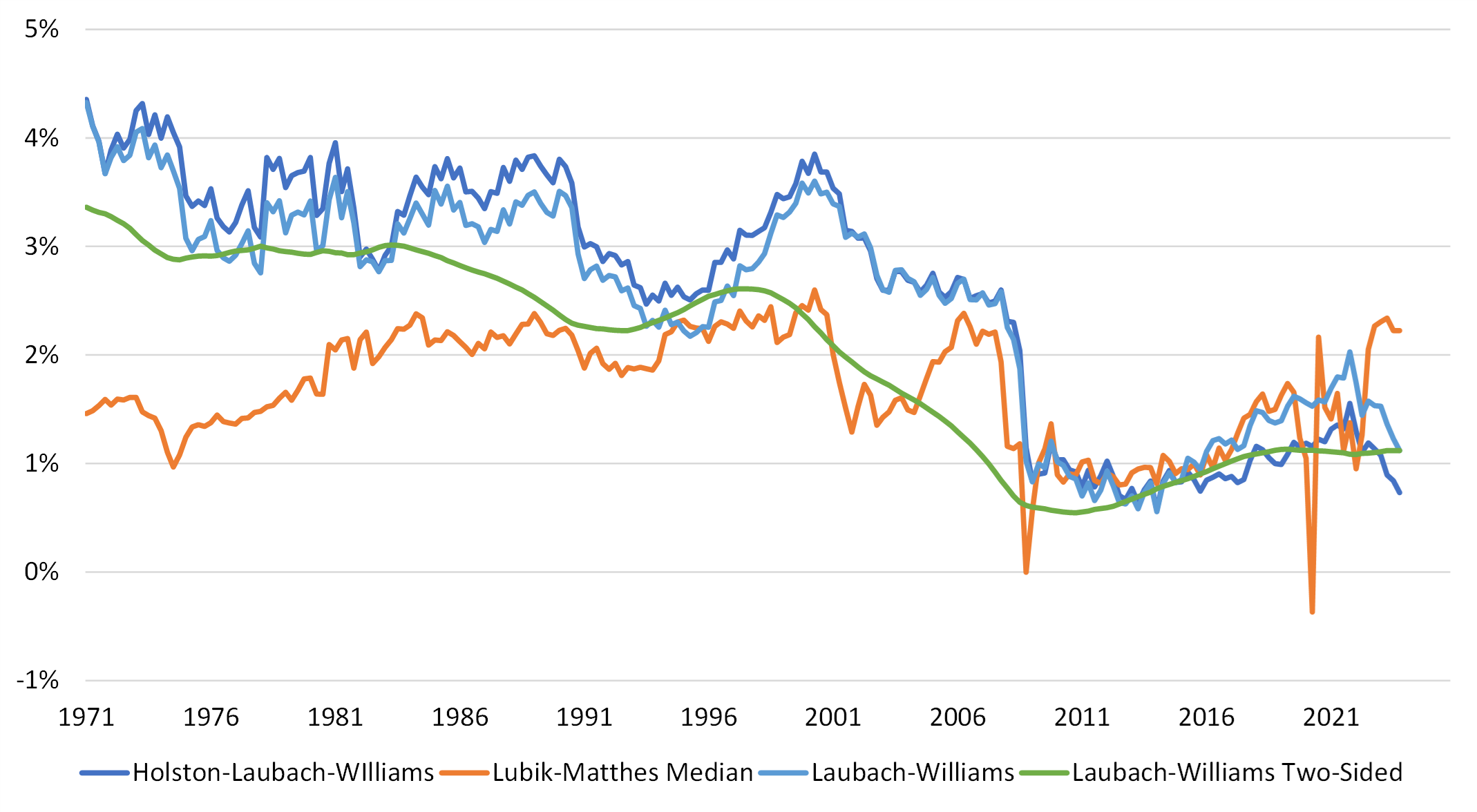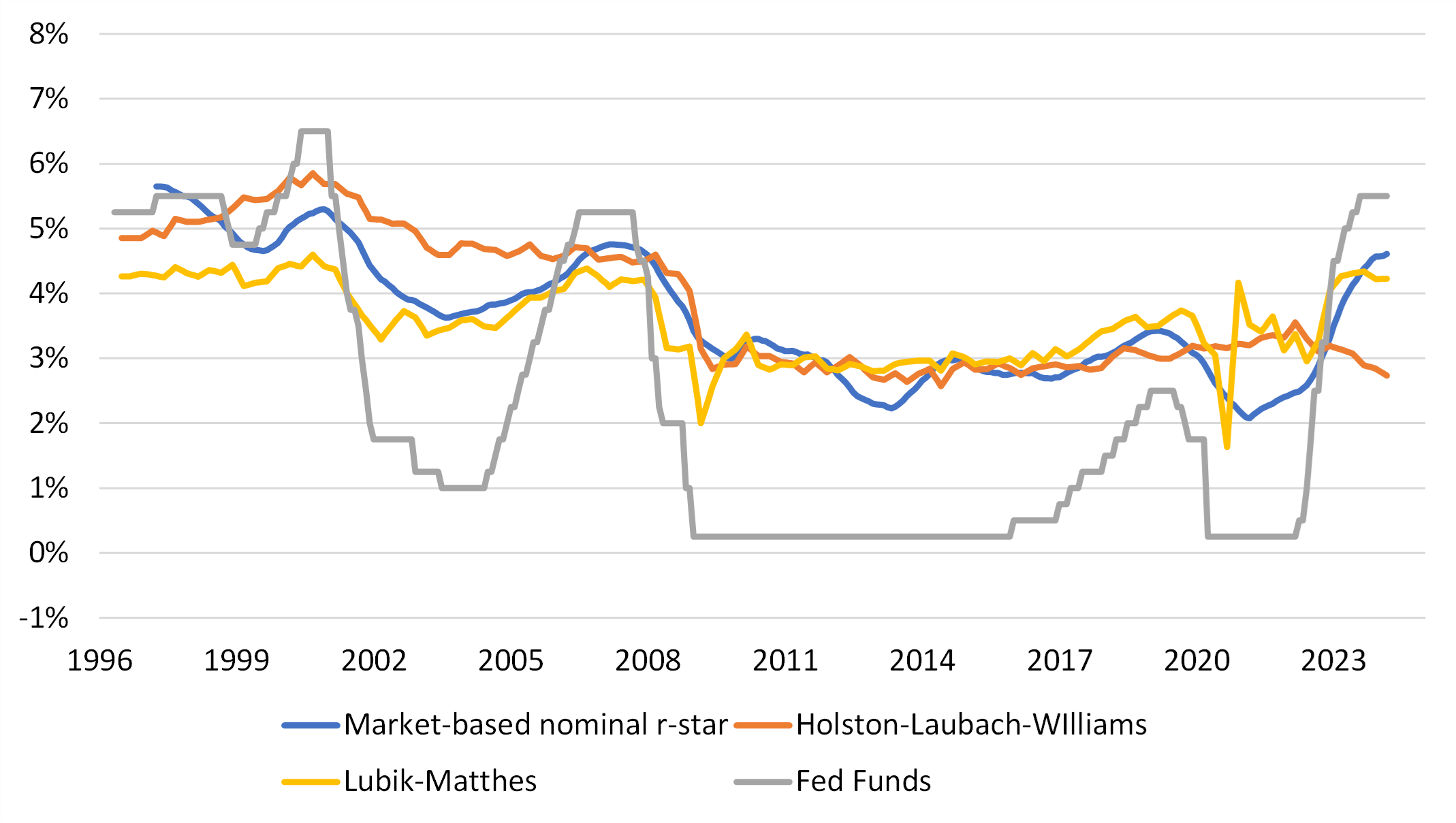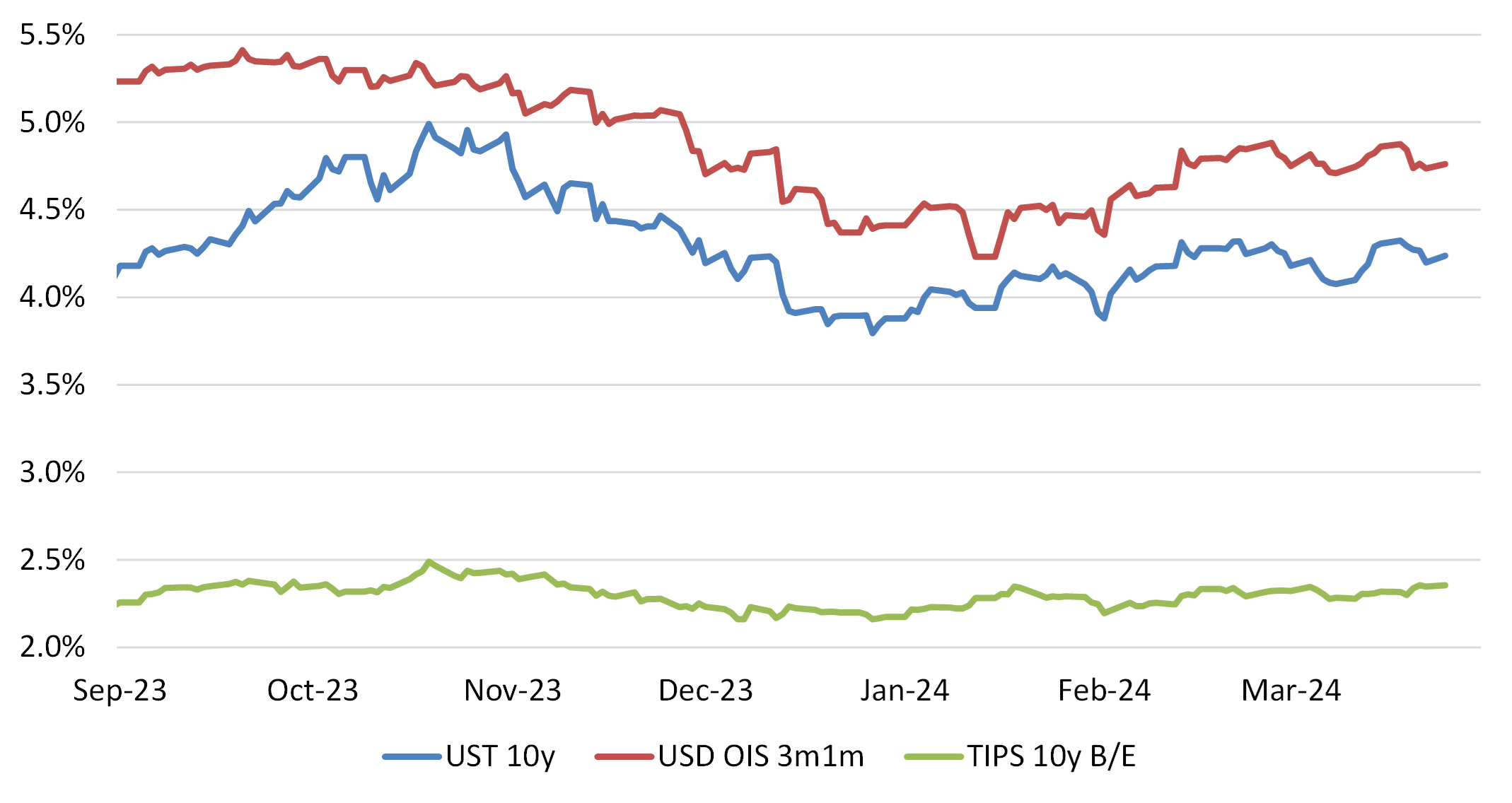
Monetary policy and the market-based R-star
- 27 Marzo 2024 (7 min di lettura)
An interest rate which cannot be observed
Conceptually, we can decompose the yield on a risk-free bond into four parts - the natural interest rate (aka ‘r-star’), monetary policy anticipation, expected inflation and risk premiums. However, the interplay between markets and central banks on the topic of the so-called ‘r-star’ – and its effect on monetary policy’s stance, bond yields and risk premia - is an intricate one.
In 2002 economists Thomas Laubach and now-New York Federal Reserve (Fed) President John Williams defined the modern view of r-star as “the real short-term interest rate consistent with output converging to potential, where potential is the level of output consistent with stable inflation”.1
More simply, it is often referred to as the short-term interest rate which would prevail when the economy is at full strength and inflation is stable.
Figure 1: US natural rate of interest estimates

Source: Bloomberg
The Fed publishes several estimates of r-star - see Figure 1. Note the wide dispersion in most recent estimates, from 0.75% to 3.1%. A similar range can be observed in Eurozone estimates which were recently published by the European Central Bank. Also, note r-star’s dynamic nature, averaging 2.5% from 1970 to 2002 before dropping to as low as 0%-0.5% in 2009 and to a similar level in the aftermath of the pandemic shock.
- PGEgaHJlZj0iaHR0cHM6Ly93d3cuZGFsbGFzZmVkLm9yZy9yZXNlYXJjaC9lY29ub21pY3MvMjAyMy8wNzAzIzp+OnRleHQ9RWNvbm9taXN0cyUyMFRob21hcyUyMExhdWJhY2glMjBhbmQlMjBub3csb3V0cHV0JTIwY29uc2lzdGVudCUyMHdpdGglMjBzdGFibGUlMjBpbmZsYXRpb24uJUUyJTgwJTlEIj5HYXppbmcgYXQgci1zdGFyOiBHYXVnaW5nIFUuUy4gbW9uZXRhcnkgcG9saWN5IHZpYSB0aGUgbmF0dXJhbCByYXRlIG9mIGludGVyZXN0IC0gRGFsbGFzZmVkLm9yZzwvYT4=
The yield curve comes to the rescue
Luckily for financial markets practitioners, yield curves are an invaluable source of information as they immediately discount complex scenarios at any forward date. For example, the forward interest rate market allows us to construct a market-based estimate of the r-star. The implied one-month interest rate in five-years’ time gives us an approximation of the future equilibrium policy interest rate expected by market participants. Adjusting this by subtracting an estimate of the term premium (the additional return required on lending for longer periods) gives us an estimate of the nominal r-star rate.(See Figure 2).
Figure 2: Model and market-based r-star

Source: AXA IM, Bloomberg
Four aspects are worthy of note:
- There is a substantial 140 basis points (bp) gap between model-based estimates. While this is entirely due to different statistical methodologies, it does highlight the level of uncertainty about the true value of this metric
- Our market-based r-star measure seems to better reflect the Lubik-Matthes estimate2 , both in terms of regimes as well as dynamics. By construction, this model-based estimate of r-star is derived from potential growth
- At around 4.5%, our market-based r-star is now 170bp above the 2009-2019 average level.
- It’s not clear how monetary policy and hence market-based r-star measures ultimately influence the true but unobservable level of r-star. Economist Gianluca Benigno (2024)3 raises the possibility that – while generally assumed to be neutral in the long-run – monetary policy “has at least very long-lasting effects on real variables”. Adding expansionary fiscal policy to a decade of quantitative easing (QE) might eventually influence the allocation of resources and productivity
Figure 3: Factors affecting US Treasury yields

Source: Bloomberg
- PGEgaHJlZj0iaHR0cHM6Ly93d3cucmljaG1vbmRmZWQub3JnL3Jlc2VhcmNoL25hdGlvbmFsX2Vjb25vbXkvbmF0dXJhbF9yYXRlX2ludGVyZXN0Ij5MdWJpay1NYXR0aGVzIE5hdHVyYWwgUmF0ZSBvZiBJbnRlcmVzdCB8IFJpY2htb25kIEZlZDwvYT4=
- PGEgaHJlZj0iaHR0cHM6Ly93d3cuYmlzLm9yZy9wdWJsL3F0cnBkZi9yX3F0MjQwM2IuaHRtIj5RdW8gdmFkaXMsIHIqPyBUaGUgbmF0dXJhbCByYXRlIG9mIGludGVyZXN0IGFmdGVyIHRoZSBwYW5kZW1pYyAoYmlzLm9yZykmbmJzcDtCZW5pZ25vLCZuYnNwO0hvZm1hbm4sJm5ic3A7TnXDsW8gQmFycmF1Jm5ic3A7YW5kIFNhbmRyaTwvYT4=
Policy uncertainty = Higher risk premium
The high level of uncertainty around r-star automatically translates into uncertainty about the monetary policy stance. Again, we can refer to an example from the Fed’s past, when measurement errors did ultimately bias its perception to the point of erroneously calibrating monetary policy at the end of the 1960s. The high and volatile inflation during the 1970s might have been partially avoided “if the Federal Reserve had possessed excellent information regarding the structure of the economy”.4
The parallel with today’s markets can be easily drawn - what if the natural interest rate was higher than current estimates? What if the long-run dot (r-star) at 2.6% failed to capture the changing structure of the economy? Evidently, the actual monetary policy stance would not be as tight as is widely believed, in which case risk premia across asset classes are probably too compressed to compensate investors for a scenario of repricing of a new interest rate regime.
In practical terms, it is likely the current level of the Fed Funds Rate is above most estimates of the r-star. Hence, policy is restrictive and inflation appears to be heading lower. This justifies market expectation of some easing of policy in the year ahead. However, the message from central bankers – perhaps reflecting their own internal discussions about the neutral rate – is that markets need to be careful about pricing in too many rate cuts. This in turn has implications for expected returns across bond markets and is a strong support for short-duration strategies in fixed income, given that yields curves are inverted and thus pricing in much lower rates in the future.
- PGEgaHJlZj0iaHR0cHM6Ly93d3cuZnJic2Yub3JnL3dwLWNvbnRlbnQvdXBsb2Fkcy93cDEwLTEyYmsucGRmIj5PcnBoYW5pZGVzL1dpbGxpYW1zICgyMDEwKTwvYT4=
Ti potrebbe interessare
Vedi tutti i contenuti

Previsioni seconda metà 2024: come investire?
- A cura di
- 26 Luglio 2024 (5 min di lettura)

Il ritorno del Regno Unito; Bund favorevoli (Luglio 2024)
- A cura di , ,
- 25 Luglio 2024 (5 min di lettura)

CIO Views: Spread europei e politiche fiscali; Sfide per la Cina
- A cura di , ,
- 25 Luglio 2024 (5 min di lettura)

Aggiornati sui mercati in modo veloce, ma approfondito
Partecipa al webinar in diretta con Alessandro Tentori, CIO Europe AXA IM, ogni martedì alle 11.00
ISCRIVITIDisclaimer
Prima dell’investimento in qualsiasi fondo gestito o promosso da AXA Investment Managers o dalle società ad essa affiliate, si prega di consultare il Prospetto e il Documento contenente le informazioni chiave per gli investitori (KID). Tali documenti, che descrivono anche i diritti degli investitori, possono essere consultati - per i fondi commercializzati in Italia - in qualsiasi momento, gratuitamente, sul sito internet www.axa-im.it e possono essere ottenuti gratuitamente, su richiesta, presso la sede di AXA Investment Managers. Il Prospetto è disponibile in lingua italiana e in lingua inglese. Il KID è disponibile nella lingua ufficiale locale del paese di distribuzione. Maggiori informazioni sulla politica dei reclami di AXA IM sono al seguente link: https://www.axa-im.it/avvertenze-legali/gestione-reclami. La sintesi dei diritti dell'investitore in inglese è disponibile sul sito web di AXA IM https://www.axa-im.com/important-information/summary-investor-rights.
I contenuti pubblicati nel presente sito internet hanno finalità informativa e non vanno intesi come ricerca in materia di investimenti o analisi su strumenti finanziari ai sensi della Direttiva MiFID II (2014/65/UE), raccomandazione, offerta o sollecitazione all’acquisto, alla sottoscrizione o alla vendita di strumenti finanziari o alla partecipazione a strategie commerciali da parte di AXA Investment Managers o di società ad essa affiliate, né la raccomandazione di una specifica strategia d'investimento o una raccomandazione personalizzata all'acquisto o alla vendita di titoli. L’investimento in qualsiasi fondo gestito o promosso da AXA Investment Managers o dalle società ad essa affiliate è accettato soltanto se proveniente da investitori che siano in possesso dei requisiti richiesti ai sensi del prospetto informativo in vigore e della relativa documentazione di offerta.
Il presente sito contiene informazioni parziali e le stime, le previsioni e i pareri qui espressi possono essere interpretati soggettivamente. Le informazioni fornite all’interno del presente sito non tengono conto degli obiettivi d’investimento individuali, della situazione finanziaria o di particolari bisogni del singolo utente. Qualsiasi opinione espressa nel presente sito internet non è una dichiarazione di fatto e non costituisce una consulenza di investimento. Le previsioni, le proiezioni o gli obiettivi sono solo indicativi e non sono garantiti in alcun modo. I rendimenti passati non sono indicativi di quelli futuri. Il valore degli investimenti e il reddito da essi derivante possono variare, sia in aumento che in diminuzione, e gli investitori potrebbero non recuperare l’importo originariamente investito.
Ancorché AXA Investment Managers impieghi ogni ragionevole sforzo per far sì che le informazioni contenute nel presente sito internet siano aggiornate ed accurate alla data di pubblicazione, non viene rilasciata alcuna garanzia in ordine all’accuratezza, affidabilità o completezza delle informazioni ivi fornite. AXA Investment Managers declina espressamente ogni responsabilità in ordine ad eventuali perdite derivanti, direttamente od indirettamente, dall’utilizzo, in qualsiasi forma e per qualsiasi finalità, delle informazioni e dei dati presenti sul sito.
AXA Investment Managers non è responsabile dell’accuratezza dei contenuti di altri siti internet eventualmente collegati a questo sito. L’esistenza di un collegamento ad un altro sito non implica approvazione da parte di AXA Investment Managers delle informazioni ivi fornite. Il contenuto del presente sito, ivi inclusi i dati, le informazioni, i grafici, i documenti, le immagini, i loghi e il nome del dominio, è di proprietà esclusiva di AXA Investment Managers e, salvo diversa specificazione, è coperto da copyright e protetto da ogni altra regolamentazione inerente alla proprietà intellettuale. In nessun caso è consentita la copia, riproduzione o diffusione delle informazioni contenute nel presente sito.
AXA Investment Managers può decidere di porre fine alle disposizioni adottate per la commercializzazione dei suoi organismi di investimento collettivo in conformità a quanto previsto dall'articolo 93 bis della direttiva 2009/65/CE.
AXA Investment Managers si riserva il diritto di aggiornare o rivedere il contenuto del presente sito internet senza preavviso.
A cura di AXA IM Paris – Sede Secondaria Italiana, Corso di Porta Romana, 68 - 20122 - Milano, sito internet www.axa-im.it.
© 2024 AXA Investment Managers. Tutti i diritti riservati.